2011年中考英语阅读理解练习宝典
图片预览
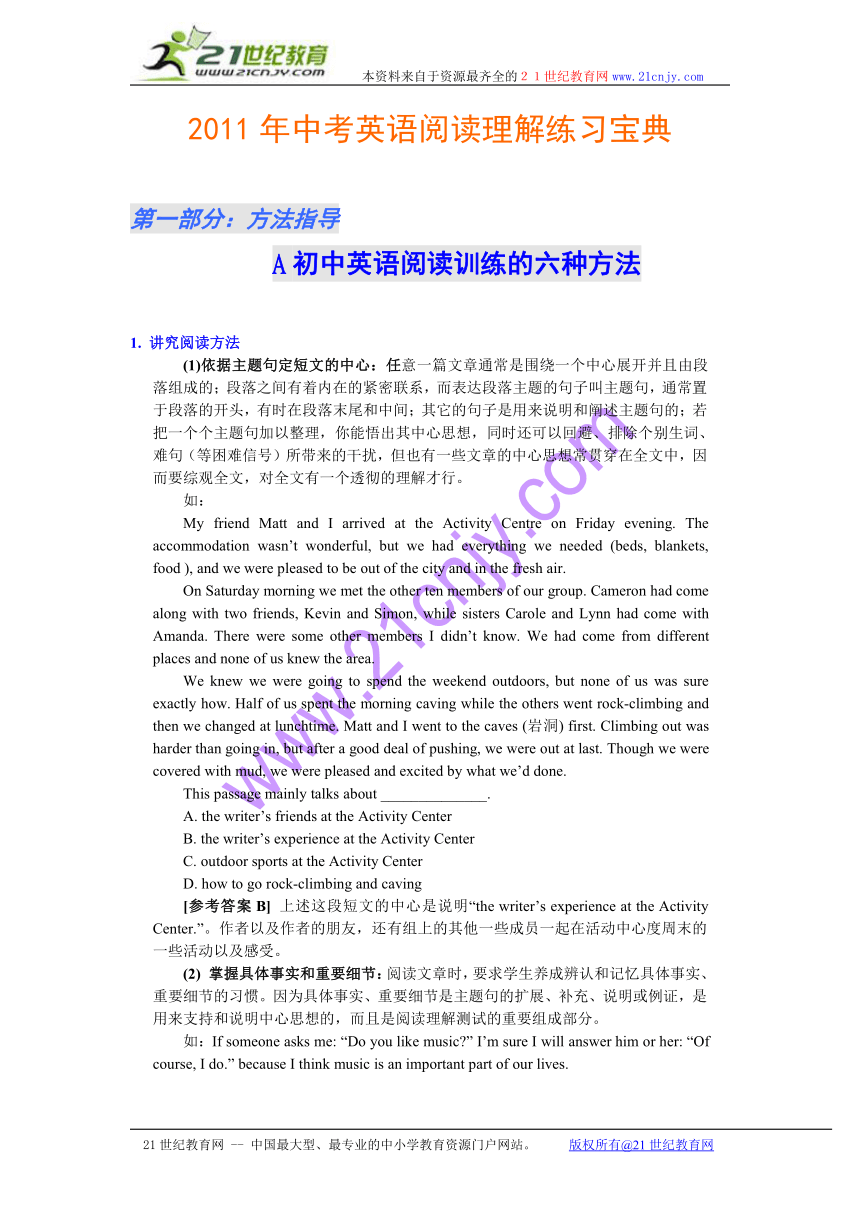
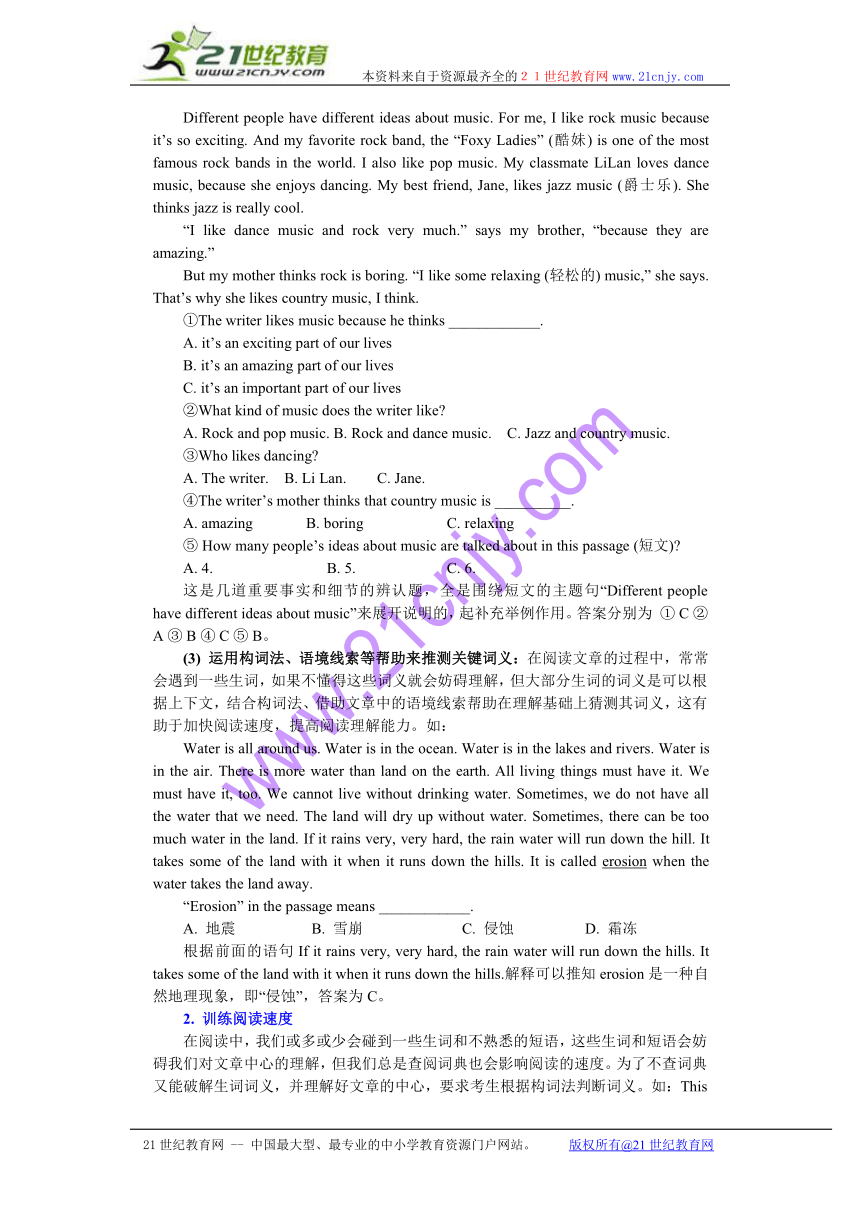
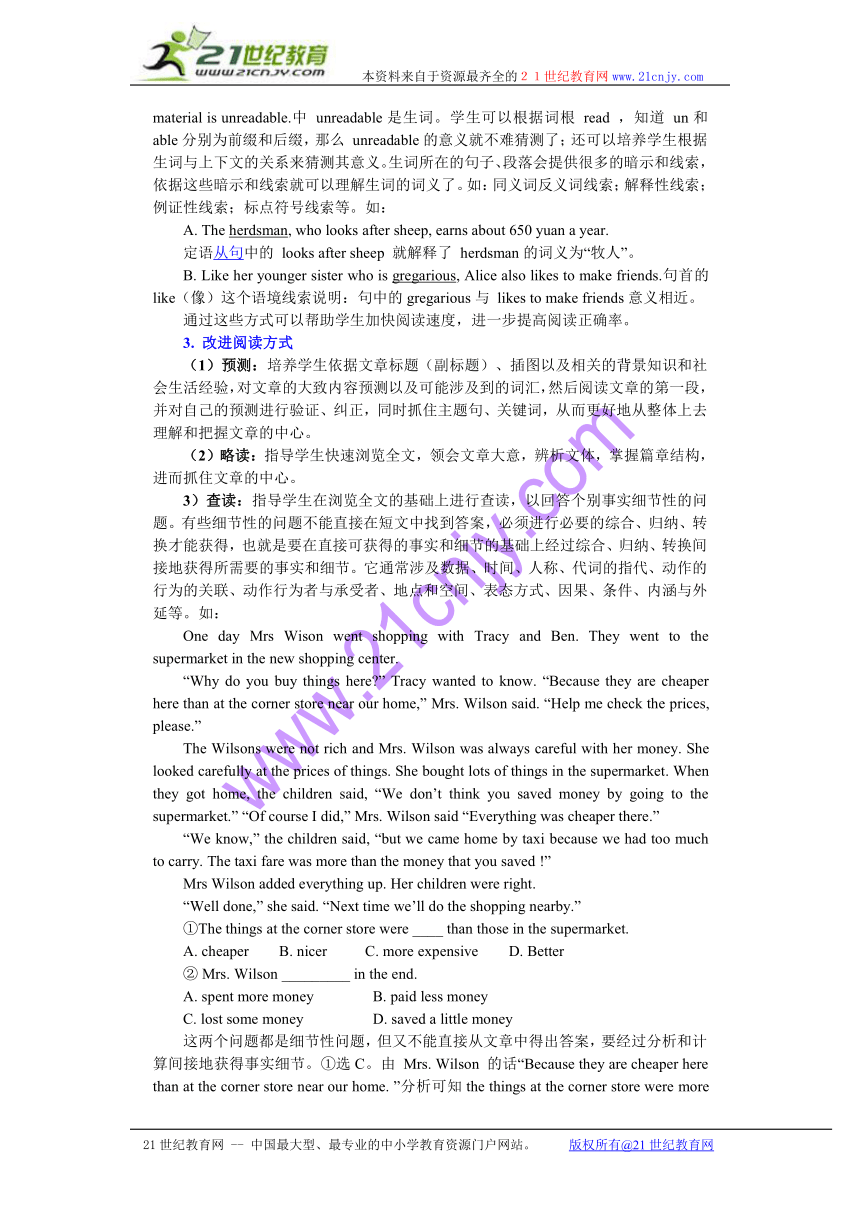
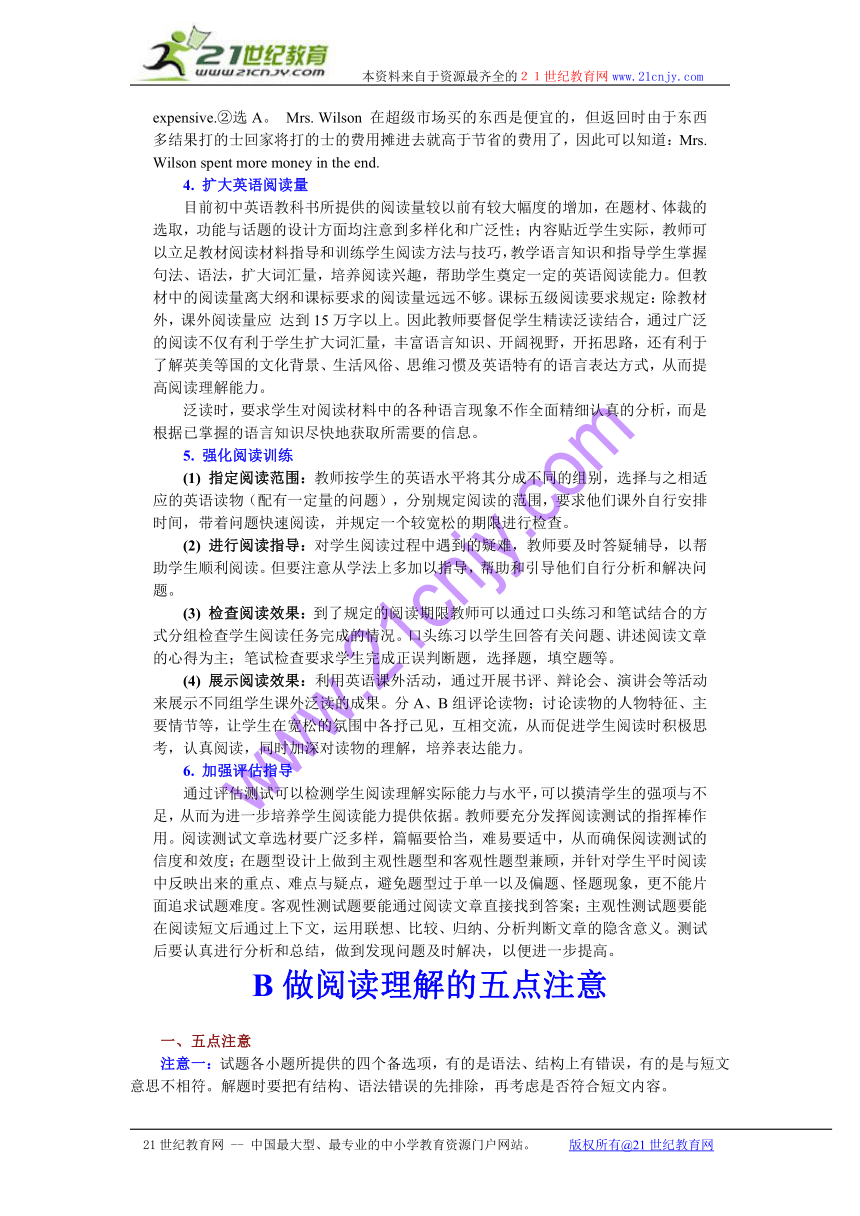
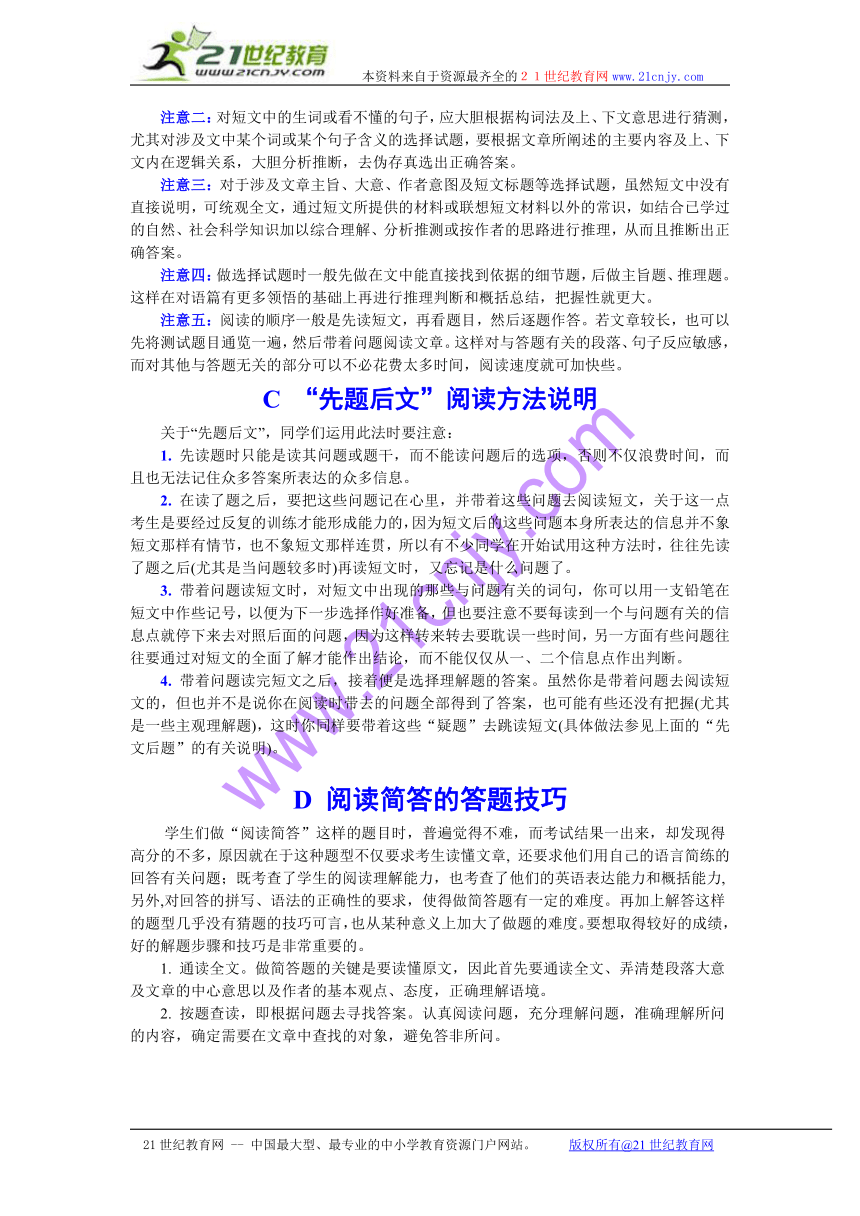
文档简介
本资料来自于资源最齐全的21世纪教育网www.21cnjy.com
2011年中考英语阅读理解练习宝典
第一部分:方法指导
A初中英语阅读训练的六种方法
1. 讲究阅读方法
(1)依据主题句定短文的中心:任意一篇文章通常是围绕一个中心展开并且由段落组成的;段落之间有着内在的紧密联系,而表达段落主题的句子叫主题句,通常置于段落的开头,有时在段落末尾和中间;其它的句子是用来说明和阐述主题句的;若把一个个主题句加以整理,你能悟出其中心思想,同时还可以回避、排除个别生词、难句(等困难信号)所带来的干扰,但也有一些文章的中心思想常贯穿在全文中,因而要综观全文,对全文有一个透彻的理解才行。
如:
My friend Matt and I arrived at the Activity Centre on Friday evening. The accommodation wasn’t wonderful, but we had everything we needed (beds, blankets, food ), and we were pleased to be out of the city and in the fresh air.
On Saturday morning we met the other ten members of our group. Cameron had come along with two friends, Kevin and Simon, while sisters Carole and Lynn had come with Amanda. There were some other members I didn’t know. We had come from different places and none of us knew the area.
We knew we were going to spend the weekend outdoors, but none of us was sure exactly how. Half of us spent the morning caving while the others went rock-climbing and then we changed at lunchtime. Matt and I went to the caves (岩洞) first. Climbing out was harder than going in, but after a good deal of pushing, we were out at last. Though we were covered with mud, we were pleased and excited by what we’d done.
This passage mainly talks about ______________.
A. the writer’s friends at the Activity Center
B. the writer’s experience at the Activity Center
C. outdoor sports at the Activity Center
D. how to go rock-climbing and caving
[参考答案B] 上述这段短文的中心是说明“the writer’s experience at the Activity Center.”。作者以及作者的朋友,还有组上的其他一些成员一起在活动中心度周末的一些活动以及感受。
(2) 掌握具体事实和重要细节:阅读文章时,要求学生养成辨认和记忆具体事实、重要细节的习惯。因为具体事实、重要细节是主题句的扩展、补充、说明或例证,是用来支持和说明中心思想的,而且是阅读理解测试的重要组成部分。
如:If someone asks me: “Do you like music ” I’m sure I will answer him or her: “Of course, I do.” because I think music is an important part of our lives.
Different people have different ideas about music. For me, I like rock music because it’s so exciting. And my favorite rock band, the “Foxy Ladies” (酷妹) is one of the most famous rock bands in the world. I also like pop music. My classmate LiLan loves dance music, because she enjoys dancing. My best friend, Jane, likes jazz music (爵士乐). She thinks jazz is really cool.
“I like dance music and rock very much.” says my brother, “because they are amazing.”
But my mother thinks rock is boring. “I like some relaxing (轻松的) music,” she says. That’s why she likes country music, I think.
①The writer likes music because he thinks ____________.
A. it’s an exciting part of our lives
B. it’s an amazing part of our lives
C. it’s an important part of our lives
②What kind of music does the writer like
A. Rock and pop music. B. Rock and dance music. C. Jazz and country music.
③Who likes dancing
A. The writer. B. Li Lan. C. Jane.
④The writer’s mother thinks that country music is __________.
A. amazing B. boring C. relaxing
⑤ How many people’s ideas about music are talked about in this passage (短文)
A. 4. B. 5. C. 6.
这是几道重要事实和细节的辨认题,全是围绕短文的主题句“Different people have different ideas about music”来展开说明的,起补充举例作用。答案分别为 ① C ② A ③ B ④ C ⑤ B。
(3) 运用构词法、语境线索等帮助来推测关键词义:在阅读文章的过程中,常常会遇到一些生词,如果不懂得这些词义就会妨碍理解,但大部分生词的词义是可以根据上下文,结合构词法、借助文章中的语境线索帮助在理解基础上猜测其词义,这有助于加快阅读速度,提高阅读理解能力。如:
Water is all around us. Water is in the ocean. Water is in the lakes and rivers. Water is in the air. There is more water than land on the earth. All living things must have it. We must have it, too. We cannot live without drinking water. Sometimes, we do not have all the water that we need. The land will dry up without water. Sometimes, there can be too much water in the land. If it rains very, very hard, the rain water will run down the hill. It takes some of the land with it when it runs down the hills. It is called erosion when the water takes the land away.
“Erosion” in the passage means ____________.
A. 地震 B. 雪崩 C. 侵蚀 D. 霜冻
根据前面的语句If it rains very, very hard, the rain water will run down the hills. It takes some of the land with it when it runs down the hills.解释可以推知erosion是一种自然地理现象,即“侵蚀”,答案为C。
2. 训练阅读速度
在阅读中,我们或多或少会碰到一些生词和不熟悉的短语,这些生词和短语会妨碍我们对文章中心的理解,但我们总是查阅词典也会影响阅读的速度。为了不查词典又能破解生词词义,并理解好文章的中心,要求考生根据构词法判断词义。如:This material is unreadable.中 unreadable是生词。学生可以根据词根 read ,知道 un和 able分别为前缀和后缀,那么 unreadable的意义就不难猜测了;还可以培养学生根据生词与上下文的关系来猜测其意义。生词所在的句子、段落会提供很多的暗示和线索,依据这些暗示和线索就可以理解生词的词义了。如:同义词反义词线索;解释性线索;例证性线索;标点符号线索等。如:
A. The herdsman, who looks after sheep, earns about 650 yuan a year.
定语从句 ( http: / / www.21cnjy.com / " \t "_blank )中的 looks after sheep 就解释了 herdsman的词义为“牧人”。
B. Like her younger sister who is gregarious, Alice also likes to make friends.句首的 like(像)这个语境线索说明:句中的gregarious与 likes to make friends意义相近。
通过这些方式可以帮助学生加快阅读速度,进一步提高阅读正确率。
3. 改进阅读方式
(1)预测:培养学生依据文章标题(副标题)、插图以及相关的背景知识和社会生活经验,对文章的大致内容预测以及可能涉及到的词汇,然后阅读文章的第一段,并对自己的预测进行验证、纠正,同时抓住主题句、关键词,从而更好地从整体上去理解和把握文章的中心。
(2)略读:指导学生快速浏览全文,领会文章大意,辨析文体,掌握篇章结构,进而抓住文章的中心。
3)查读:指导学生在浏览全文的基础上进行查读,以回答个别事实细节性的问题。有些细节性的问题不能直接在短文中找到答案,必须进行必要的综合、归纳、转换才能获得,也就是要在直接可获得的事实和细节的基础上经过综合、归纳、转换间接地获得所需要的事实和细节。它通常涉及数据、时间、人称、代词的指代、动作的行为的关联、动作行为者与承受者、地点和空间、表态方式、因果、条件、内涵与外延等。如:
One day Mrs Wison went shopping with Tracy and Ben. They went to the supermarket in the new shopping center.
“Why do you buy things here ” Tracy wanted to know. “Because they are cheaper here than at the corner store near our home,” Mrs. Wilson said. “Help me check the prices, please.”
The Wilsons were not rich and Mrs. Wilson was always careful with her money. She looked carefully at the prices of things. She bought lots of things in the supermarket. When they got home, the children said, “We don’t think you saved money by going to the supermarket.” “Of course I did,” Mrs. Wilson said “Everything was cheaper there.”
“We know,” the children said, “but we came home by taxi because we had too much to carry. The taxi fare was more than the money that you saved !”
Mrs Wilson added everything up. Her children were right.
“Well done,” she said. “Next time we’ll do the shopping nearby.”
①The things at the corner store were ____ than those in the supermarket.
A. cheaper B. nicer C. more expensive D. Better
② Mrs. Wilson _________ in the end.
A. spent more money B. paid less money
C. lost some money D. saved a little money
这两个问题都是细节性问题,但又不能直接从文章中得出答案,要经过分析和计算间接地获得事实细节。①选C。由 Mrs. Wilson 的话“Because they are cheaper here than at the corner store near our home. ”分析可知the things at the corner store were more expensive.②选A。 Mrs. Wilson 在超级市场买的东西是便宜的,但返回时由于东西多结果打的士回家将打的士的费用摊进去就高于节省的费用了,因此可以知道:Mrs. Wilson spent more money in the end.
4. 扩大英语阅读量
目前初中英语教科书所提供的阅读量较以前有较大幅度的增加,在题材、体裁的选取,功能与话题的设计方面均注意到多样化和广泛性;内容贴近学生实际,教师可以立足教材阅读材料指导和训练学生阅读方法与技巧,教学语言知识和指导学生掌握句法、语法,扩大词汇量,培养阅读兴趣,帮助学生奠定一定的英语阅读能力。但教材中的阅读量离大纲和课标要求的阅读量远远不够。课标五级阅读要求规定:除教材外,课外阅读量应 达到15万字以上。因此教师要督促学生精读泛读结合,通过广泛的阅读不仅有利于学生扩大词汇量,丰富语言知识、开阔视野,开拓思路,还有利于了解英美等国的文化背景、生活风俗、思维习惯及英语特有的语言表达方式,从而提高阅读理解能力。
泛读时,要求学生对阅读材料中的各种语言现象不作全面精细认真的分析,而是根据已掌握的语言知识尽快地获取所需要的信息。
5. 强化阅读训练
(1) 指定阅读范围:教师按学生的英语水平将其分成不同的组别,选择与之相适应的英语读物(配有一定量的问题),分别规定阅读的范围,要求他们课外自行安排时间,带着问题快速阅读,并规定一个较宽松的期限进行检查。
(2) 进行阅读指导:对学生阅读过程中遇到的疑难,教师要及时答疑辅导,以帮助学生顺利阅读。但要注意从学法上多加以指导,帮助和引导他们自行分析和解决问题。
(3) 检查阅读效果:到了规定的阅读期限教师可以通过口头练习和笔试结合的方式分组检查学生阅读任务完成的情况。口头练习以学生回答有关问题、讲述阅读文章的心得为主;笔试检查要求学生完成正误判断题,选择题,填空题等。
(4) 展示阅读效果:利用英语课外活动,通过开展书评、辩论会、演讲会等活动来展示不同组学生课外泛读的成果。分A、B组评论读物;讨论读物的人物特征、主要情节等,让学生在宽松的氛围中各抒己见,互相交流,从而促进学生阅读时积极思考,认真阅读,同时加深对读物的理解,培养表达能力。
6. 加强评估指导
通过评估测试可以检测学生阅读理解实际能力与水平,可以摸清学生的强项与不足,从而为进一步培养学生阅读能力提供依据。教师要充分发挥阅读测试的指挥棒作用。阅读测试文章选材要广泛多样,篇幅要恰当,难易要适中,从而确保阅读测试的信度和效度;在题型设计上做到主观性题型和客观性题型兼顾,并针对学生平时阅读中反映出来的重点、难点与疑点,避免题型过于单一以及偏题、怪题现象,更不能片面追求试题难度。客观性测试题要能通过阅读文章直接找到答案;主观性测试题要能在阅读短文后通过上下文,运用联想、比较、归纳、分析判断文章的隐含意义。测试后要认真进行分析和总结,做到发现问题及时解决,以便进一步提高。
B做阅读理解的五点注意
一、五点注意
注意一:试题各小题所提供的四个备选项,有的是语法、结构上有错误,有的是与短文意思不相符。解题时要把有结构、语法错误的先排除,再考虑是否符合短文内容。
注意二:对短文中的生词或看不懂的句子,应大胆根据构词法及上、下文意思进行猜测,尤其对涉及文中某个词或某个句子含义的选择试题,要根据文章所阐述的主要内容及上、下文内在逻辑关系,大胆分析推断,去伪存真选出正确答案。
注意三:对于涉及文章主旨、大意、作者意图及短文标题等选择试题,虽然短文中没有直接说明,可统观全文,通过短文所提供的材料或联想短文材料以外的常识,如结合已学过的自然、社会科学知识加以综合理解、分析推测或按作者的思路进行推理,从而且推断出正确答案。
注意四:做选择试题时一般先做在文中能直接找到依据的细节题,后做主旨题、推理题。这样在对语篇有更多领悟的基础上再进行推理判断和概括总结,把握性就更大。
注意五:阅读的顺序一般是先读短文,再看题目,然后逐题作答。若文章较长,也可以先将测试题目通览一遍,然后带着问题阅读文章。这样对与答题有关的段落、句子反应敏感,而对其他与答题无关的部分可以不必花费太多时间,阅读速度就可加快些。
C “先题后文”阅读方法说明
关于“先题后文”,同学们运用此法时要注意:
1. 先读题时只能是读其问题或题干,而不能读问题后的选项,否则不仅浪费时间,而且也无法记住众多答案所表达的众多信息。
2. 在读了题之后,要把这些问题记在心里,并带着这些问题去阅读短文,关于这一点考生是要经过反复的训练才能形成能力的,因为短文后的这些问题本身所表达的信息并不象短文那样有情节,也不象短文那样连贯,所以有不少同学在开始试用这种方法时,往往先读了题之后(尤其是当问题较多时)再读短文时,又忘记是什么问题了。
3. 带着问题读短文时,对短文中出现的那些与问题有关的词句,你可以用一支铅笔在短文中作些记号,以便为下一步选择作好准备,但也要注意不要每读到一个与问题有关的信息点就停下来去对照后面的问题,因为这样转来转去要耽误一些时间,另一方面有些问题往往要通过对短文的全面了解才能作出结论,而不能仅仅从一、二个信息点作出判断。
4. 带着问题读完短文之后,接着便是选择理解题的答案。虽然你是带着问题去阅读短文的,但也并不是说你在阅读时带去的问题全部得到了答案,也可能有些还没有把握(尤其是一些主观理解题),这时你同样要带着这些“疑题”去跳读短文(具体做法参见上面的“先文后题”的有关说明)。
D 阅读简答的答题技巧
学生们做“阅读简答”这样的题目时,普遍觉得不难,而考试结果一出来,却发现得高分的不多,原因就在于这种题型不仅要求考生读懂文章, 还要求他们用自己的语言简练的回答有关问题;既考查了学生的阅读理解能力,也考查了他们的英语表达能力和概括能力,另外,对回答的拼写、语法的正确性的要求,使得做简答题有一定的难度。再加上解答这样的题型几乎没有猜题的技巧可言,也从某种意义上加大了做题的难度。要想取得较好的成绩,好的解题步骤和技巧是非常重要的。
1. 通读全文。做简答题的关键是要读懂原文,因此首先要通读全文、弄清楚段落大意及文章的中心意思以及作者的基本观点、态度,正确理解语境。
2. 按题查读,即根据问题去寻找答案。认真阅读问题,充分理解问题,准确理解所问的内容,确定需要在文章中查找的对象,避免答非所问。
3. 简练作答。在基本确定了每道题的回答内容之后,就要用简练、准确的英语表达出来。注意回答问题时要切中要点,不要画蛇添足。组织答案时,注意避免语言错误,如:时态 ( http: / / www.21cnjy.com / " \t "_blank )、主谓一致、句子结构和拼写等。如需引用原文,要作适当改动,最好不要整句照搬.
4. 认真核查。完成所填的答案以后,再将原短文和补全后的短文或句子放在一起,审读一遍,上下对比参照,逐一检查所填的词是否符合原文主旨和细节,是否答非所问,是否仍存在语法、词汇拼写等错误,另外还有一点也要注意:如果对字数有要求, 是否符合要求。
5. 答案形式要符合提问方式。不同类型的问题要求有不同形式的回答,不能仅仅为了答案的简洁而忽略了问题与回答在形式上的对应。如原文中提问方式为“why”,那么就要用“because”引导的从句 ( http: / / www.21cnjy.com / " \t "_blank )来回答。
答题时值得注意的是:根据语境、先定词义、后定词形。因此首先得纵观全文,围绕中心意思,综合考虑来确定词义,保证所填的词符合全文的大意。查读相关的段落或词句时,应仔细对照留有空格的句子或问题,找出充足的依据来确定该空格应填词的词义。所填的词还必须符合语法正确的原则,必须从词语搭配、句型结构以及人称、时态 ( http: / / www.21cnjy.com / " \t "_blank )、语态上来判定所填词的正确形式,所填的词以实词为主,有些要填的词可以从原短文中直接找到答案。
E如何应对阅读理解中的细节题和推理题
一、做细节事实题的方法
在阅读理解题目中,有相当一部分是考查细节和事实的题目。这类题目相对容易一些。这些题目有两个共同特点:(1) 凡属针对特定细节的考题,其正确答案大都可以在阅读材料中找到对应的文字部分作为验证。这一部分可能是一个词或短语,也可能是一个句子或相关的若干句子,但句式、用词和表达方式不同。(2) 干扰项往往是主体思想与细节混杂,正确答案细节和非正确答案的细节混杂,甚至真假混杂。因此,要做好阅读理解中的确定细节和事实的题目,一要在文章中找出相应的信息点,二要排除干扰项。
二、做推理判断题的方法
所谓推断,就是根据阅读材料中所提供的信息,推断出未知的信息。即把有关的文字作为已知部分,从中推断出未知部分。据以推断的有关文字可能是词或句子,也可能是若干句子,甚至是全文。中考英语 ( http: / / www.21cnjy.com / " \t "_blank )试题中的推断题主要有以下几种:
1.事实推断
这种推断常常针对某一个或几个具体细节,是比较简单的推断。进行这种推断,要首先在文章中找出据以推断的有关文字,然后加以分析,尤其要悟出字里行间的意思。例如:
According to the passage, which of the following can you most possibly watch on TV
A. You often play football with your friends after school.
B. Your teacher has got a cold.
C. A tiger in the city zoo has run out and hasn’t been caught.
D. The bike in front of your house is lost.
在阅读材料中,有这样一段文字:
Secondly, a news story has to be interesting and unusual. People don’t want to read stories about everyday life. As a result, many stories are about some kind of danger and seem to be “bad” news.
根据这段文字,我们可以推断:电视报道的新闻故事必须是有趣的和不平常的。因此,正确答案应为C。
2.指代推断
确定代词的含义和指代对象是阅读理解题常见的题目。要确定指代词所指代的对象,关键在于对所在上下文的正确理解。指代名词的指代词,其单复数形式 ( http: / / www.21cnjy.com / " \t "_blank )英语被指代的词一致,因此数的形式可作为识别指代对象第一个辅助标志。
3.逻辑推断
这类题目往往是要求根据文章所提供的背景,人物的表情,动作和语言来推断出人物的态度或感觉。
4.对作者的意图和态度的推断
这一类考题大都要求考生就作者对论述对象持什么样的态度做出推断,如作者对所陈述的观点是赞同、反对,还是犹豫不定,对记述或描写的人、物或事件是赞颂、同情、冷漠,还是厌恶。作者的这种思想倾向和感彩不一定直接表述出来,而往往隐含在字里行间。因此,进行这种推断时,我们既要依靠短文的主题思想作为推力的前提,又要注意作者的措辞,尤其是形容词一类的修饰语。
F 如何猜测阅读理解题中的生词词义
词汇是阅读理解的基础的基础。我们必须掌握教材中所学所有的单词和词组;了解构词法知识,如熟记一些常见的前缀、后缀,以及词语的合成和转化等;并且要进行大量的课外阅读扩大自己的词汇量。要阅读需要一定的词汇量,同时在大量阅读的同时不仅可以复习学过的词汇而且还可扩大自己的词汇量。尽管如此,在阅读中还是不可避免会遇到生词或者熟词生义,在英语阅读理解试题中猜测词义也是必不可少的题目,因此,我们必须学会如何猜测词义。任何一个词语,在一定的上下文中只能表示一个确定的词义。据此,我们可以尽可能地利用上下文来猜测词义,即从已知推求未知,也就是用我们所熟悉的词或短语来猜测我们不熟悉的词的词义。猜测词义时,我们可以从以下几个方面来考虑:
一、根据定义或解释猜测词义
A bag is useful and the word “bag” is useful. It gives us some interesting phrases(短语). One is “ to let the cat out of the bag”. It is the same as “to tell a secret”….
Now when someone lets out (泄漏) a secret, he “lets the cat out of the bag.”
John “lets the cat out of the bag” means he ______.
A. makes everyone know a secret B. the woman bout a cat
C. buys a cat in the bag D. sells the cat in the bag
在这篇文章里,“let the cat out of the bag”虽然是一个新出现的短语,但紧接着后面就给出解释It is the same as “to tell a secret”根据这一解释,我们就可判断出正确答案应为A。
二、根据情景和逻辑进行判断
As they go around town, the police help people. Sometimes they find lost children. They take the children home. If the police see a fight, they put an end to it right away. Sometimes people will ask the police how to get to a place in town. The police can always tell the people which way to go. They know all the streets and roads well.
In the text, “put an end to” means “______”.
A. stop B. cut C. kill D. fly
根据文章所提供的情景,如果警察看到有人在打架,他们肯定会去制止。因为制止打架斗殴是警察的职责。根据这一推理,答案应该是A。
三、根据并列或同位关系猜测词义
There is a place on our earth where hot water and steam come up under the ground. It is on a large island in the Pacific Ocean. The island is North Island in New Zealand.
What does the word “steam” mean in Chinese
A. 自来水 B. 大气 C. 冰川 D. 蒸汽
从语法上看,steam和hot water是并列关系,我们就以断定这两种东西是相关的,是同一类物质。在所给第四个选项中只有“蒸汽”有这种可能。
四、根据背景和常识判断
The following morning when I went to see how my captive (caged) bird was doing, I discovered it on the floor of the cage, dead. I was terribly surprised! What had happened! I had taken extremely care of my little bird. Arthur Wayne, the famous ornithologist, who happened to be visiting my father at the time, hearing me crying over the death of my bird, explained what had happened. “A mother mockingbird, finding her young in a cage, will sometimes bring it poison berries(毒莓). She thinks it better for her young to die than to live in captivity.”
An ornithologist is probably a person who ______.
A. studies birds B. loves creatures C. majors in habits D. takes care of trees
Ornithologist 这个词从来没有见到过,但是通过他的语言我们可以判断出这是一个对鸟很有研究的人。我很爱鸟,把鸟装在笼子里,并细心照料,而且鸟的母亲也飞过来喂这只鸟,但这只鸟却死了,我很不理解。到我家来的这个人给我详细解释了鸟死的原因,说明这个人非常懂鸟。据此,我们可以断定答案影视A。
G 利用主题句解阅读理解题
最有效的办法是找出主题句。一篇文章(或一段文章) 通常都是围绕一个中心意思展开的。而这个中心意思往往由一个句子来概括。这个能概括文章或段落中心意思的句子叫做主题句。因此,理解一个段落或一篇文章的中心意思首先要学会寻找主题句。主题句一般具有三个特点:(1) 概括性强:表述的意思比较概括。(2) 结构简单:句子结构较简单,多数都不采用长、难句的形式。(3) 受它支撑:段落中其他的句子是用来解释、支撑或发展该句所表述的主题思想。在一篇短文或一个段落中,大部分主题句的位置情况有三种:
一、主题句在段首或篇首
主题句在段首或篇首的情况相当普遍。一般新闻报道、说明文, 议论文大都采用先总述,后分述的叙事方法。例如:
All living things on the earth need other living things to live. Nothing lives alone. Most animals must live in a group, and even a plant grows close together with others of the same kind. Sometimes one living thing kills another, one eats and the other is eaten. Each kind of life eats another kind of life in order to live, and together they form a food chain(食物链)。Some food chains become broken up if one of the links disappears.
第一句即是主题句。这个句子概括了本段的中心意思:“地球上所有的生物要生存都离不开其他的生物”。后面讲述了大量的事实之后,作者指出:如果这些食物链中的一个链环消失,所有的食物都会断掉。所有这些事实都是围绕第一个句子展开的。
二、主题句在段末或篇末
用归纳法写文章时,往往表述细节的句子在前,概述性的句子在后,并以此结尾。这种位于段末或篇末的主题句往往是对前面细节的归纳总结或者所得出的结论。例如:
If you buy some well-made clothes, you can save money because they can last longer. They look good even after they have been washed many times. Sometimes some clothes cost more money, but it does not mean that they are always better made, or they always fit better. In other words, some less expensive clothes look and fit better than more expensive clothes.
这段文章前面列举了两件事实,最后一句是对这两个事实的概括:有些价钱便宜的衣服比价钱贵的衣服更好看,更合身。段末这个句子就是主题句。
三、无主题句
有时,一篇文章里并没有明显的主题句。这时我们应该怎样来确定文章的主题或中心意思呢?其实这也不难。我们可以首先找出每一段的中心意思,各段的中心意思往往都是围绕一个中心来展开的,或者说是来说明一个问题的。这个中心或这个问题就是这篇文章的主题或中心意思。
Killer bees started in Brazil 1957. A scientist in Sao Paulo wanted bees to make more honey(蜂蜜). So he put forty-six African bees with some Brazilian bees. The bees bred(繁殖) and made a new kind of bees. But the new bees were a mistake. They didn’t want to make more honey. They wanted to attack. Then, by accident, twenty-six African bees escaped and bred with the Brazilian bees outside.
Scientists could not control(控制) the problem. The bees increased fast. They went from Brazil to Venezuela. Then they went to Central America. Now they are in North America. They travel about 390 miles a year. Each group of bees grows four times a year. This means one million new groups every five years.
Why are people afraid of killer bees People are afraid for two reasons. First, the bees sting(叮) many more times than usual bees. Killer bees can sting sixty times a minute nonstop for two hours. Second, killer bees attack in groups. Four hundred bee stings can kill a person.
Already several hundred people are dead. Now killer bees are in Texas. In a few years they will reach all over the United States. People can do nothing but wait.
这篇短文表面看起来没有主题句,那末怎样来确定它的中心意思呢?按照上面的说明,我们先找出每一段的大意:第一段讲的是killer bees的产生。第二段讲的是 killer bees 的急剧增加。第三段讲的是人们害怕 killer bees 的原因。第四段讲的是 killer bees 已经杀死的人数和将来的状况。从这几段的大意可以看出这篇文章自始至终都是围绕 killer bees 这一中心展开的。换句话说,killer bees 就是这篇文章的主题。
H短文改写填空型阅读理解实例分析
一、实例训练
Robert is fifteen now. Two and a half years ago he came to the city and began to study in a middle school. He studies hard and gets on well with his classmates. And he often helps his friends with their lessons. But as he comes from a village, the headmaster who was born in a rich family is bad to him and does his best to make excuses to punish him. The boy knows it and takes precautions against(提防) it.
One afternoon all the students went to have lunch and he bought a piece of bread. He was reading a book under a big tree, while a dog was standing near him. At that moment the headmaster came out and saw it. He became angry and said, “Don’t you know we don’t let anybody rear (饲养) dogs in the school ”
“Yes, I do, sir. ”said the boy.
“Why have you brought your dog to school, then ”
“It isn’t my dog. ”
“Why is it following you, then ”
“You’re following me now, sir. ” said the boy, “Can you say you are mine ”
请根据以上短文在改写后短文的空白处填入适当的词,使其完整。
Robert is fifteen. He is in Grade _______(1) now. He studies hard and his classmates are _______(2) to him. And he often helps his friends to _______(3) their lessons. But as he was _______(4) in a farmer family, the headmaster from a _______(5) family is bad to him and does_______(6) he can to punish him.
One day in the _______(7), all the students went _______(8) lunch and he bought a piece of bread, reading a book under a tree. At the moment a dog was standing near him. _______(9) the headmaster saw this, he wanted to_______(10) him. But he failed that day again.
二、答题分析
第一步:快读全文,掌握大意。通读原文我们知道。文章讲叙了Robert 和校长的一些情况,Robert 是一个初中学生,他出生于贫困之家,但学习努力与同学相处融洽。校长出生于富贵家庭对Robert很不友好,总是想尽办法惩罚他, Robert时刻小心提防他。一天下午校长又想趁机惩罚他,但未能得逞。
第二步:细读改写,寻找异同。如原文中说Two and half years ago he came to the city and began to study in a middle school. 而改写中却是He is in Grade_______(1) now. 由原文中的Two and half years ago 可知第(1)空要填Three. 原文中说He studies hard and gets on well with his classmates, 而改写中却是He studies hard and his classmates are _______(2) to him. 由于“他与同学相处融洽”那么“他的同学一定是对他很友好了”。因此第二空填kind或friendly。第3空是一个典型的同义句改写,即help sb. with sth. 与help sb. to do sth. 的转换。
第三步:字斟句酌,各个击破。比如第4, 5, 7空与原文几乎没多大差别可先填好(4) born, (5) rich, (7) afternoon。对于与原文有较大差异的空,则需要字斟句酌,细仔推敲了。我们要在对比改写文中的句子与原文句子差别的前提下,推测改写文中的句子所要表达的意思,然后根据我们所学的知识推出所要填写的单词。如:
原文中的and does his best to make excuses to punish him 正是改写文中and does _______(6) he can to punish him 要表达的意思。这里does后面是一个宾语从句,而从句 ( http: / / www.21cnjy.com / " \t "_blank )缺少引导词,因此填入what正合适。这一空较难因为can后面省去了动词原形 ( http: / / www.21cnjy.com / " \t "_blank )do。这句话意为“并且做他所能做的事情来惩罚他”。
而原文中的…all the students went to have lunch 与改写文中的all the students went _______(8) lunch. went to have lunch 与went for lunch 同义。故第8空填for。
改写中的_______(9) the headmaster saw this, he wanted to _______(10) him. But he failed that day again. 是对原文第二段后面部分的概括,通过比较我们知道改写中要表达的意思是“当校长看见那种情况时,他想惩罚他,但那一天他又失败了”。因此第9空填,when第10空填punish。
第四步:复读改写,纠正失误。如:第1空应大写首字母,很多考生可能会忽略这一点。
21世纪教育网 -- 中国最大型、最专业的中小学教育资源门户网站。 版权所有@21世纪教育网
2011年中考英语阅读理解练习宝典
第一部分:方法指导
A初中英语阅读训练的六种方法
1. 讲究阅读方法
(1)依据主题句定短文的中心:任意一篇文章通常是围绕一个中心展开并且由段落组成的;段落之间有着内在的紧密联系,而表达段落主题的句子叫主题句,通常置于段落的开头,有时在段落末尾和中间;其它的句子是用来说明和阐述主题句的;若把一个个主题句加以整理,你能悟出其中心思想,同时还可以回避、排除个别生词、难句(等困难信号)所带来的干扰,但也有一些文章的中心思想常贯穿在全文中,因而要综观全文,对全文有一个透彻的理解才行。
如:
My friend Matt and I arrived at the Activity Centre on Friday evening. The accommodation wasn’t wonderful, but we had everything we needed (beds, blankets, food ), and we were pleased to be out of the city and in the fresh air.
On Saturday morning we met the other ten members of our group. Cameron had come along with two friends, Kevin and Simon, while sisters Carole and Lynn had come with Amanda. There were some other members I didn’t know. We had come from different places and none of us knew the area.
We knew we were going to spend the weekend outdoors, but none of us was sure exactly how. Half of us spent the morning caving while the others went rock-climbing and then we changed at lunchtime. Matt and I went to the caves (岩洞) first. Climbing out was harder than going in, but after a good deal of pushing, we were out at last. Though we were covered with mud, we were pleased and excited by what we’d done.
This passage mainly talks about ______________.
A. the writer’s friends at the Activity Center
B. the writer’s experience at the Activity Center
C. outdoor sports at the Activity Center
D. how to go rock-climbing and caving
[参考答案B] 上述这段短文的中心是说明“the writer’s experience at the Activity Center.”。作者以及作者的朋友,还有组上的其他一些成员一起在活动中心度周末的一些活动以及感受。
(2) 掌握具体事实和重要细节:阅读文章时,要求学生养成辨认和记忆具体事实、重要细节的习惯。因为具体事实、重要细节是主题句的扩展、补充、说明或例证,是用来支持和说明中心思想的,而且是阅读理解测试的重要组成部分。
如:If someone asks me: “Do you like music ” I’m sure I will answer him or her: “Of course, I do.” because I think music is an important part of our lives.
Different people have different ideas about music. For me, I like rock music because it’s so exciting. And my favorite rock band, the “Foxy Ladies” (酷妹) is one of the most famous rock bands in the world. I also like pop music. My classmate LiLan loves dance music, because she enjoys dancing. My best friend, Jane, likes jazz music (爵士乐). She thinks jazz is really cool.
“I like dance music and rock very much.” says my brother, “because they are amazing.”
But my mother thinks rock is boring. “I like some relaxing (轻松的) music,” she says. That’s why she likes country music, I think.
①The writer likes music because he thinks ____________.
A. it’s an exciting part of our lives
B. it’s an amazing part of our lives
C. it’s an important part of our lives
②What kind of music does the writer like
A. Rock and pop music. B. Rock and dance music. C. Jazz and country music.
③Who likes dancing
A. The writer. B. Li Lan. C. Jane.
④The writer’s mother thinks that country music is __________.
A. amazing B. boring C. relaxing
⑤ How many people’s ideas about music are talked about in this passage (短文)
A. 4. B. 5. C. 6.
这是几道重要事实和细节的辨认题,全是围绕短文的主题句“Different people have different ideas about music”来展开说明的,起补充举例作用。答案分别为 ① C ② A ③ B ④ C ⑤ B。
(3) 运用构词法、语境线索等帮助来推测关键词义:在阅读文章的过程中,常常会遇到一些生词,如果不懂得这些词义就会妨碍理解,但大部分生词的词义是可以根据上下文,结合构词法、借助文章中的语境线索帮助在理解基础上猜测其词义,这有助于加快阅读速度,提高阅读理解能力。如:
Water is all around us. Water is in the ocean. Water is in the lakes and rivers. Water is in the air. There is more water than land on the earth. All living things must have it. We must have it, too. We cannot live without drinking water. Sometimes, we do not have all the water that we need. The land will dry up without water. Sometimes, there can be too much water in the land. If it rains very, very hard, the rain water will run down the hill. It takes some of the land with it when it runs down the hills. It is called erosion when the water takes the land away.
“Erosion” in the passage means ____________.
A. 地震 B. 雪崩 C. 侵蚀 D. 霜冻
根据前面的语句If it rains very, very hard, the rain water will run down the hills. It takes some of the land with it when it runs down the hills.解释可以推知erosion是一种自然地理现象,即“侵蚀”,答案为C。
2. 训练阅读速度
在阅读中,我们或多或少会碰到一些生词和不熟悉的短语,这些生词和短语会妨碍我们对文章中心的理解,但我们总是查阅词典也会影响阅读的速度。为了不查词典又能破解生词词义,并理解好文章的中心,要求考生根据构词法判断词义。如:This material is unreadable.中 unreadable是生词。学生可以根据词根 read ,知道 un和 able分别为前缀和后缀,那么 unreadable的意义就不难猜测了;还可以培养学生根据生词与上下文的关系来猜测其意义。生词所在的句子、段落会提供很多的暗示和线索,依据这些暗示和线索就可以理解生词的词义了。如:同义词反义词线索;解释性线索;例证性线索;标点符号线索等。如:
A. The herdsman, who looks after sheep, earns about 650 yuan a year.
定语从句 ( http: / / www.21cnjy.com / " \t "_blank )中的 looks after sheep 就解释了 herdsman的词义为“牧人”。
B. Like her younger sister who is gregarious, Alice also likes to make friends.句首的 like(像)这个语境线索说明:句中的gregarious与 likes to make friends意义相近。
通过这些方式可以帮助学生加快阅读速度,进一步提高阅读正确率。
3. 改进阅读方式
(1)预测:培养学生依据文章标题(副标题)、插图以及相关的背景知识和社会生活经验,对文章的大致内容预测以及可能涉及到的词汇,然后阅读文章的第一段,并对自己的预测进行验证、纠正,同时抓住主题句、关键词,从而更好地从整体上去理解和把握文章的中心。
(2)略读:指导学生快速浏览全文,领会文章大意,辨析文体,掌握篇章结构,进而抓住文章的中心。
3)查读:指导学生在浏览全文的基础上进行查读,以回答个别事实细节性的问题。有些细节性的问题不能直接在短文中找到答案,必须进行必要的综合、归纳、转换才能获得,也就是要在直接可获得的事实和细节的基础上经过综合、归纳、转换间接地获得所需要的事实和细节。它通常涉及数据、时间、人称、代词的指代、动作的行为的关联、动作行为者与承受者、地点和空间、表态方式、因果、条件、内涵与外延等。如:
One day Mrs Wison went shopping with Tracy and Ben. They went to the supermarket in the new shopping center.
“Why do you buy things here ” Tracy wanted to know. “Because they are cheaper here than at the corner store near our home,” Mrs. Wilson said. “Help me check the prices, please.”
The Wilsons were not rich and Mrs. Wilson was always careful with her money. She looked carefully at the prices of things. She bought lots of things in the supermarket. When they got home, the children said, “We don’t think you saved money by going to the supermarket.” “Of course I did,” Mrs. Wilson said “Everything was cheaper there.”
“We know,” the children said, “but we came home by taxi because we had too much to carry. The taxi fare was more than the money that you saved !”
Mrs Wilson added everything up. Her children were right.
“Well done,” she said. “Next time we’ll do the shopping nearby.”
①The things at the corner store were ____ than those in the supermarket.
A. cheaper B. nicer C. more expensive D. Better
② Mrs. Wilson _________ in the end.
A. spent more money B. paid less money
C. lost some money D. saved a little money
这两个问题都是细节性问题,但又不能直接从文章中得出答案,要经过分析和计算间接地获得事实细节。①选C。由 Mrs. Wilson 的话“Because they are cheaper here than at the corner store near our home. ”分析可知the things at the corner store were more expensive.②选A。 Mrs. Wilson 在超级市场买的东西是便宜的,但返回时由于东西多结果打的士回家将打的士的费用摊进去就高于节省的费用了,因此可以知道:Mrs. Wilson spent more money in the end.
4. 扩大英语阅读量
目前初中英语教科书所提供的阅读量较以前有较大幅度的增加,在题材、体裁的选取,功能与话题的设计方面均注意到多样化和广泛性;内容贴近学生实际,教师可以立足教材阅读材料指导和训练学生阅读方法与技巧,教学语言知识和指导学生掌握句法、语法,扩大词汇量,培养阅读兴趣,帮助学生奠定一定的英语阅读能力。但教材中的阅读量离大纲和课标要求的阅读量远远不够。课标五级阅读要求规定:除教材外,课外阅读量应 达到15万字以上。因此教师要督促学生精读泛读结合,通过广泛的阅读不仅有利于学生扩大词汇量,丰富语言知识、开阔视野,开拓思路,还有利于了解英美等国的文化背景、生活风俗、思维习惯及英语特有的语言表达方式,从而提高阅读理解能力。
泛读时,要求学生对阅读材料中的各种语言现象不作全面精细认真的分析,而是根据已掌握的语言知识尽快地获取所需要的信息。
5. 强化阅读训练
(1) 指定阅读范围:教师按学生的英语水平将其分成不同的组别,选择与之相适应的英语读物(配有一定量的问题),分别规定阅读的范围,要求他们课外自行安排时间,带着问题快速阅读,并规定一个较宽松的期限进行检查。
(2) 进行阅读指导:对学生阅读过程中遇到的疑难,教师要及时答疑辅导,以帮助学生顺利阅读。但要注意从学法上多加以指导,帮助和引导他们自行分析和解决问题。
(3) 检查阅读效果:到了规定的阅读期限教师可以通过口头练习和笔试结合的方式分组检查学生阅读任务完成的情况。口头练习以学生回答有关问题、讲述阅读文章的心得为主;笔试检查要求学生完成正误判断题,选择题,填空题等。
(4) 展示阅读效果:利用英语课外活动,通过开展书评、辩论会、演讲会等活动来展示不同组学生课外泛读的成果。分A、B组评论读物;讨论读物的人物特征、主要情节等,让学生在宽松的氛围中各抒己见,互相交流,从而促进学生阅读时积极思考,认真阅读,同时加深对读物的理解,培养表达能力。
6. 加强评估指导
通过评估测试可以检测学生阅读理解实际能力与水平,可以摸清学生的强项与不足,从而为进一步培养学生阅读能力提供依据。教师要充分发挥阅读测试的指挥棒作用。阅读测试文章选材要广泛多样,篇幅要恰当,难易要适中,从而确保阅读测试的信度和效度;在题型设计上做到主观性题型和客观性题型兼顾,并针对学生平时阅读中反映出来的重点、难点与疑点,避免题型过于单一以及偏题、怪题现象,更不能片面追求试题难度。客观性测试题要能通过阅读文章直接找到答案;主观性测试题要能在阅读短文后通过上下文,运用联想、比较、归纳、分析判断文章的隐含意义。测试后要认真进行分析和总结,做到发现问题及时解决,以便进一步提高。
B做阅读理解的五点注意
一、五点注意
注意一:试题各小题所提供的四个备选项,有的是语法、结构上有错误,有的是与短文意思不相符。解题时要把有结构、语法错误的先排除,再考虑是否符合短文内容。
注意二:对短文中的生词或看不懂的句子,应大胆根据构词法及上、下文意思进行猜测,尤其对涉及文中某个词或某个句子含义的选择试题,要根据文章所阐述的主要内容及上、下文内在逻辑关系,大胆分析推断,去伪存真选出正确答案。
注意三:对于涉及文章主旨、大意、作者意图及短文标题等选择试题,虽然短文中没有直接说明,可统观全文,通过短文所提供的材料或联想短文材料以外的常识,如结合已学过的自然、社会科学知识加以综合理解、分析推测或按作者的思路进行推理,从而且推断出正确答案。
注意四:做选择试题时一般先做在文中能直接找到依据的细节题,后做主旨题、推理题。这样在对语篇有更多领悟的基础上再进行推理判断和概括总结,把握性就更大。
注意五:阅读的顺序一般是先读短文,再看题目,然后逐题作答。若文章较长,也可以先将测试题目通览一遍,然后带着问题阅读文章。这样对与答题有关的段落、句子反应敏感,而对其他与答题无关的部分可以不必花费太多时间,阅读速度就可加快些。
C “先题后文”阅读方法说明
关于“先题后文”,同学们运用此法时要注意:
1. 先读题时只能是读其问题或题干,而不能读问题后的选项,否则不仅浪费时间,而且也无法记住众多答案所表达的众多信息。
2. 在读了题之后,要把这些问题记在心里,并带着这些问题去阅读短文,关于这一点考生是要经过反复的训练才能形成能力的,因为短文后的这些问题本身所表达的信息并不象短文那样有情节,也不象短文那样连贯,所以有不少同学在开始试用这种方法时,往往先读了题之后(尤其是当问题较多时)再读短文时,又忘记是什么问题了。
3. 带着问题读短文时,对短文中出现的那些与问题有关的词句,你可以用一支铅笔在短文中作些记号,以便为下一步选择作好准备,但也要注意不要每读到一个与问题有关的信息点就停下来去对照后面的问题,因为这样转来转去要耽误一些时间,另一方面有些问题往往要通过对短文的全面了解才能作出结论,而不能仅仅从一、二个信息点作出判断。
4. 带着问题读完短文之后,接着便是选择理解题的答案。虽然你是带着问题去阅读短文的,但也并不是说你在阅读时带去的问题全部得到了答案,也可能有些还没有把握(尤其是一些主观理解题),这时你同样要带着这些“疑题”去跳读短文(具体做法参见上面的“先文后题”的有关说明)。
D 阅读简答的答题技巧
学生们做“阅读简答”这样的题目时,普遍觉得不难,而考试结果一出来,却发现得高分的不多,原因就在于这种题型不仅要求考生读懂文章, 还要求他们用自己的语言简练的回答有关问题;既考查了学生的阅读理解能力,也考查了他们的英语表达能力和概括能力,另外,对回答的拼写、语法的正确性的要求,使得做简答题有一定的难度。再加上解答这样的题型几乎没有猜题的技巧可言,也从某种意义上加大了做题的难度。要想取得较好的成绩,好的解题步骤和技巧是非常重要的。
1. 通读全文。做简答题的关键是要读懂原文,因此首先要通读全文、弄清楚段落大意及文章的中心意思以及作者的基本观点、态度,正确理解语境。
2. 按题查读,即根据问题去寻找答案。认真阅读问题,充分理解问题,准确理解所问的内容,确定需要在文章中查找的对象,避免答非所问。
3. 简练作答。在基本确定了每道题的回答内容之后,就要用简练、准确的英语表达出来。注意回答问题时要切中要点,不要画蛇添足。组织答案时,注意避免语言错误,如:时态 ( http: / / www.21cnjy.com / " \t "_blank )、主谓一致、句子结构和拼写等。如需引用原文,要作适当改动,最好不要整句照搬.
4. 认真核查。完成所填的答案以后,再将原短文和补全后的短文或句子放在一起,审读一遍,上下对比参照,逐一检查所填的词是否符合原文主旨和细节,是否答非所问,是否仍存在语法、词汇拼写等错误,另外还有一点也要注意:如果对字数有要求, 是否符合要求。
5. 答案形式要符合提问方式。不同类型的问题要求有不同形式的回答,不能仅仅为了答案的简洁而忽略了问题与回答在形式上的对应。如原文中提问方式为“why”,那么就要用“because”引导的从句 ( http: / / www.21cnjy.com / " \t "_blank )来回答。
答题时值得注意的是:根据语境、先定词义、后定词形。因此首先得纵观全文,围绕中心意思,综合考虑来确定词义,保证所填的词符合全文的大意。查读相关的段落或词句时,应仔细对照留有空格的句子或问题,找出充足的依据来确定该空格应填词的词义。所填的词还必须符合语法正确的原则,必须从词语搭配、句型结构以及人称、时态 ( http: / / www.21cnjy.com / " \t "_blank )、语态上来判定所填词的正确形式,所填的词以实词为主,有些要填的词可以从原短文中直接找到答案。
E如何应对阅读理解中的细节题和推理题
一、做细节事实题的方法
在阅读理解题目中,有相当一部分是考查细节和事实的题目。这类题目相对容易一些。这些题目有两个共同特点:(1) 凡属针对特定细节的考题,其正确答案大都可以在阅读材料中找到对应的文字部分作为验证。这一部分可能是一个词或短语,也可能是一个句子或相关的若干句子,但句式、用词和表达方式不同。(2) 干扰项往往是主体思想与细节混杂,正确答案细节和非正确答案的细节混杂,甚至真假混杂。因此,要做好阅读理解中的确定细节和事实的题目,一要在文章中找出相应的信息点,二要排除干扰项。
二、做推理判断题的方法
所谓推断,就是根据阅读材料中所提供的信息,推断出未知的信息。即把有关的文字作为已知部分,从中推断出未知部分。据以推断的有关文字可能是词或句子,也可能是若干句子,甚至是全文。中考英语 ( http: / / www.21cnjy.com / " \t "_blank )试题中的推断题主要有以下几种:
1.事实推断
这种推断常常针对某一个或几个具体细节,是比较简单的推断。进行这种推断,要首先在文章中找出据以推断的有关文字,然后加以分析,尤其要悟出字里行间的意思。例如:
According to the passage, which of the following can you most possibly watch on TV
A. You often play football with your friends after school.
B. Your teacher has got a cold.
C. A tiger in the city zoo has run out and hasn’t been caught.
D. The bike in front of your house is lost.
在阅读材料中,有这样一段文字:
Secondly, a news story has to be interesting and unusual. People don’t want to read stories about everyday life. As a result, many stories are about some kind of danger and seem to be “bad” news.
根据这段文字,我们可以推断:电视报道的新闻故事必须是有趣的和不平常的。因此,正确答案应为C。
2.指代推断
确定代词的含义和指代对象是阅读理解题常见的题目。要确定指代词所指代的对象,关键在于对所在上下文的正确理解。指代名词的指代词,其单复数形式 ( http: / / www.21cnjy.com / " \t "_blank )英语被指代的词一致,因此数的形式可作为识别指代对象第一个辅助标志。
3.逻辑推断
这类题目往往是要求根据文章所提供的背景,人物的表情,动作和语言来推断出人物的态度或感觉。
4.对作者的意图和态度的推断
这一类考题大都要求考生就作者对论述对象持什么样的态度做出推断,如作者对所陈述的观点是赞同、反对,还是犹豫不定,对记述或描写的人、物或事件是赞颂、同情、冷漠,还是厌恶。作者的这种思想倾向和感彩不一定直接表述出来,而往往隐含在字里行间。因此,进行这种推断时,我们既要依靠短文的主题思想作为推力的前提,又要注意作者的措辞,尤其是形容词一类的修饰语。
F 如何猜测阅读理解题中的生词词义
词汇是阅读理解的基础的基础。我们必须掌握教材中所学所有的单词和词组;了解构词法知识,如熟记一些常见的前缀、后缀,以及词语的合成和转化等;并且要进行大量的课外阅读扩大自己的词汇量。要阅读需要一定的词汇量,同时在大量阅读的同时不仅可以复习学过的词汇而且还可扩大自己的词汇量。尽管如此,在阅读中还是不可避免会遇到生词或者熟词生义,在英语阅读理解试题中猜测词义也是必不可少的题目,因此,我们必须学会如何猜测词义。任何一个词语,在一定的上下文中只能表示一个确定的词义。据此,我们可以尽可能地利用上下文来猜测词义,即从已知推求未知,也就是用我们所熟悉的词或短语来猜测我们不熟悉的词的词义。猜测词义时,我们可以从以下几个方面来考虑:
一、根据定义或解释猜测词义
A bag is useful and the word “bag” is useful. It gives us some interesting phrases(短语). One is “ to let the cat out of the bag”. It is the same as “to tell a secret”….
Now when someone lets out (泄漏) a secret, he “lets the cat out of the bag.”
John “lets the cat out of the bag” means he ______.
A. makes everyone know a secret B. the woman bout a cat
C. buys a cat in the bag D. sells the cat in the bag
在这篇文章里,“let the cat out of the bag”虽然是一个新出现的短语,但紧接着后面就给出解释It is the same as “to tell a secret”根据这一解释,我们就可判断出正确答案应为A。
二、根据情景和逻辑进行判断
As they go around town, the police help people. Sometimes they find lost children. They take the children home. If the police see a fight, they put an end to it right away. Sometimes people will ask the police how to get to a place in town. The police can always tell the people which way to go. They know all the streets and roads well.
In the text, “put an end to” means “______”.
A. stop B. cut C. kill D. fly
根据文章所提供的情景,如果警察看到有人在打架,他们肯定会去制止。因为制止打架斗殴是警察的职责。根据这一推理,答案应该是A。
三、根据并列或同位关系猜测词义
There is a place on our earth where hot water and steam come up under the ground. It is on a large island in the Pacific Ocean. The island is North Island in New Zealand.
What does the word “steam” mean in Chinese
A. 自来水 B. 大气 C. 冰川 D. 蒸汽
从语法上看,steam和hot water是并列关系,我们就以断定这两种东西是相关的,是同一类物质。在所给第四个选项中只有“蒸汽”有这种可能。
四、根据背景和常识判断
The following morning when I went to see how my captive (caged) bird was doing, I discovered it on the floor of the cage, dead. I was terribly surprised! What had happened! I had taken extremely care of my little bird. Arthur Wayne, the famous ornithologist, who happened to be visiting my father at the time, hearing me crying over the death of my bird, explained what had happened. “A mother mockingbird, finding her young in a cage, will sometimes bring it poison berries(毒莓). She thinks it better for her young to die than to live in captivity.”
An ornithologist is probably a person who ______.
A. studies birds B. loves creatures C. majors in habits D. takes care of trees
Ornithologist 这个词从来没有见到过,但是通过他的语言我们可以判断出这是一个对鸟很有研究的人。我很爱鸟,把鸟装在笼子里,并细心照料,而且鸟的母亲也飞过来喂这只鸟,但这只鸟却死了,我很不理解。到我家来的这个人给我详细解释了鸟死的原因,说明这个人非常懂鸟。据此,我们可以断定答案影视A。
G 利用主题句解阅读理解题
最有效的办法是找出主题句。一篇文章(或一段文章) 通常都是围绕一个中心意思展开的。而这个中心意思往往由一个句子来概括。这个能概括文章或段落中心意思的句子叫做主题句。因此,理解一个段落或一篇文章的中心意思首先要学会寻找主题句。主题句一般具有三个特点:(1) 概括性强:表述的意思比较概括。(2) 结构简单:句子结构较简单,多数都不采用长、难句的形式。(3) 受它支撑:段落中其他的句子是用来解释、支撑或发展该句所表述的主题思想。在一篇短文或一个段落中,大部分主题句的位置情况有三种:
一、主题句在段首或篇首
主题句在段首或篇首的情况相当普遍。一般新闻报道、说明文, 议论文大都采用先总述,后分述的叙事方法。例如:
All living things on the earth need other living things to live. Nothing lives alone. Most animals must live in a group, and even a plant grows close together with others of the same kind. Sometimes one living thing kills another, one eats and the other is eaten. Each kind of life eats another kind of life in order to live, and together they form a food chain(食物链)。Some food chains become broken up if one of the links disappears.
第一句即是主题句。这个句子概括了本段的中心意思:“地球上所有的生物要生存都离不开其他的生物”。后面讲述了大量的事实之后,作者指出:如果这些食物链中的一个链环消失,所有的食物都会断掉。所有这些事实都是围绕第一个句子展开的。
二、主题句在段末或篇末
用归纳法写文章时,往往表述细节的句子在前,概述性的句子在后,并以此结尾。这种位于段末或篇末的主题句往往是对前面细节的归纳总结或者所得出的结论。例如:
If you buy some well-made clothes, you can save money because they can last longer. They look good even after they have been washed many times. Sometimes some clothes cost more money, but it does not mean that they are always better made, or they always fit better. In other words, some less expensive clothes look and fit better than more expensive clothes.
这段文章前面列举了两件事实,最后一句是对这两个事实的概括:有些价钱便宜的衣服比价钱贵的衣服更好看,更合身。段末这个句子就是主题句。
三、无主题句
有时,一篇文章里并没有明显的主题句。这时我们应该怎样来确定文章的主题或中心意思呢?其实这也不难。我们可以首先找出每一段的中心意思,各段的中心意思往往都是围绕一个中心来展开的,或者说是来说明一个问题的。这个中心或这个问题就是这篇文章的主题或中心意思。
Killer bees started in Brazil 1957. A scientist in Sao Paulo wanted bees to make more honey(蜂蜜). So he put forty-six African bees with some Brazilian bees. The bees bred(繁殖) and made a new kind of bees. But the new bees were a mistake. They didn’t want to make more honey. They wanted to attack. Then, by accident, twenty-six African bees escaped and bred with the Brazilian bees outside.
Scientists could not control(控制) the problem. The bees increased fast. They went from Brazil to Venezuela. Then they went to Central America. Now they are in North America. They travel about 390 miles a year. Each group of bees grows four times a year. This means one million new groups every five years.
Why are people afraid of killer bees People are afraid for two reasons. First, the bees sting(叮) many more times than usual bees. Killer bees can sting sixty times a minute nonstop for two hours. Second, killer bees attack in groups. Four hundred bee stings can kill a person.
Already several hundred people are dead. Now killer bees are in Texas. In a few years they will reach all over the United States. People can do nothing but wait.
这篇短文表面看起来没有主题句,那末怎样来确定它的中心意思呢?按照上面的说明,我们先找出每一段的大意:第一段讲的是killer bees的产生。第二段讲的是 killer bees 的急剧增加。第三段讲的是人们害怕 killer bees 的原因。第四段讲的是 killer bees 已经杀死的人数和将来的状况。从这几段的大意可以看出这篇文章自始至终都是围绕 killer bees 这一中心展开的。换句话说,killer bees 就是这篇文章的主题。
H短文改写填空型阅读理解实例分析
一、实例训练
Robert is fifteen now. Two and a half years ago he came to the city and began to study in a middle school. He studies hard and gets on well with his classmates. And he often helps his friends with their lessons. But as he comes from a village, the headmaster who was born in a rich family is bad to him and does his best to make excuses to punish him. The boy knows it and takes precautions against(提防) it.
One afternoon all the students went to have lunch and he bought a piece of bread. He was reading a book under a big tree, while a dog was standing near him. At that moment the headmaster came out and saw it. He became angry and said, “Don’t you know we don’t let anybody rear (饲养) dogs in the school ”
“Yes, I do, sir. ”said the boy.
“Why have you brought your dog to school, then ”
“It isn’t my dog. ”
“Why is it following you, then ”
“You’re following me now, sir. ” said the boy, “Can you say you are mine ”
请根据以上短文在改写后短文的空白处填入适当的词,使其完整。
Robert is fifteen. He is in Grade _______(1) now. He studies hard and his classmates are _______(2) to him. And he often helps his friends to _______(3) their lessons. But as he was _______(4) in a farmer family, the headmaster from a _______(5) family is bad to him and does_______(6) he can to punish him.
One day in the _______(7), all the students went _______(8) lunch and he bought a piece of bread, reading a book under a tree. At the moment a dog was standing near him. _______(9) the headmaster saw this, he wanted to_______(10) him. But he failed that day again.
二、答题分析
第一步:快读全文,掌握大意。通读原文我们知道。文章讲叙了Robert 和校长的一些情况,Robert 是一个初中学生,他出生于贫困之家,但学习努力与同学相处融洽。校长出生于富贵家庭对Robert很不友好,总是想尽办法惩罚他, Robert时刻小心提防他。一天下午校长又想趁机惩罚他,但未能得逞。
第二步:细读改写,寻找异同。如原文中说Two and half years ago he came to the city and began to study in a middle school. 而改写中却是He is in Grade_______(1) now. 由原文中的Two and half years ago 可知第(1)空要填Three. 原文中说He studies hard and gets on well with his classmates, 而改写中却是He studies hard and his classmates are _______(2) to him. 由于“他与同学相处融洽”那么“他的同学一定是对他很友好了”。因此第二空填kind或friendly。第3空是一个典型的同义句改写,即help sb. with sth. 与help sb. to do sth. 的转换。
第三步:字斟句酌,各个击破。比如第4, 5, 7空与原文几乎没多大差别可先填好(4) born, (5) rich, (7) afternoon。对于与原文有较大差异的空,则需要字斟句酌,细仔推敲了。我们要在对比改写文中的句子与原文句子差别的前提下,推测改写文中的句子所要表达的意思,然后根据我们所学的知识推出所要填写的单词。如:
原文中的and does his best to make excuses to punish him 正是改写文中and does _______(6) he can to punish him 要表达的意思。这里does后面是一个宾语从句,而从句 ( http: / / www.21cnjy.com / " \t "_blank )缺少引导词,因此填入what正合适。这一空较难因为can后面省去了动词原形 ( http: / / www.21cnjy.com / " \t "_blank )do。这句话意为“并且做他所能做的事情来惩罚他”。
而原文中的…all the students went to have lunch 与改写文中的all the students went _______(8) lunch. went to have lunch 与went for lunch 同义。故第8空填for。
改写中的_______(9) the headmaster saw this, he wanted to _______(10) him. But he failed that day again. 是对原文第二段后面部分的概括,通过比较我们知道改写中要表达的意思是“当校长看见那种情况时,他想惩罚他,但那一天他又失败了”。因此第9空填,when第10空填punish。
第四步:复读改写,纠正失误。如:第1空应大写首字母,很多考生可能会忽略这一点。
21世纪教育网 -- 中国最大型、最专业的中小学教育资源门户网站。 版权所有@21世纪教育网
同课章节目录
- 词法
- 名词
- 动词和动词短语
- 动词语态
- 动词时态
- 助动词和情态动词
- 非谓语动词
- 冠词
- 代词
- 数词和量词
- 形容词副词及其比较等级
- 介词和介词短语
- 连词和感叹词
- 构词法
- 相似、相近词比较
- 句法
- 陈述句
- 一般疑问句和否定疑问句
- 特殊疑问句及选择疑问句
- 反意疑问句
- 存在句(There be句型)
- 宾语从句
- 定语从句
- 状语从句
- 主谓一致问题
- 简单句
- 并列句
- 复合句
- 主谓一致
- 主、表语从句
- 名词性从句
- 直接引语和间接引语
- 虚拟语气
- 感叹句
- 强调句
- 倒装句
- 祈使句
- 句子的成分
- 句子的分类
- 题型专区
- 单项选择部分
- 易错题
- 完形填空
- 阅读理解
- 词汇练习
- 听说训练
- 句型转换
- 补全对话
- 短文改错
- 翻译
- 书面表达
- 任务型阅读
- 语法填空
- 其他资料
